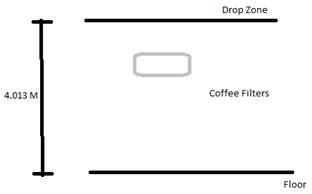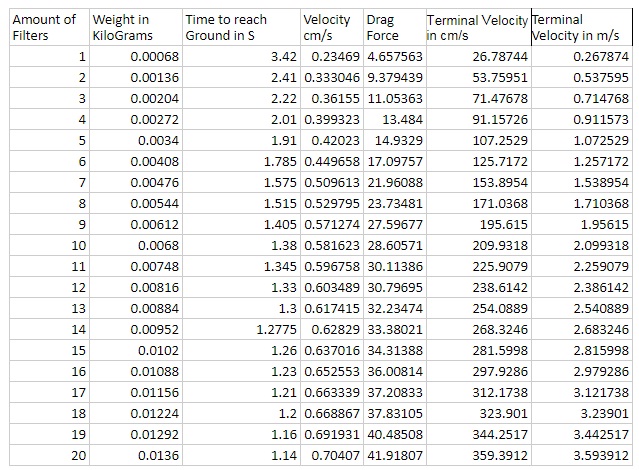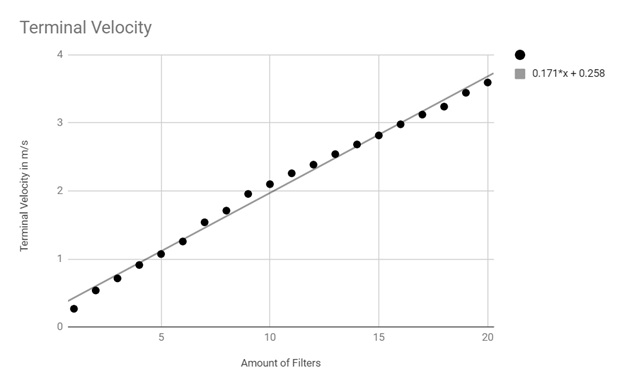





Published on Apr 02, 2024
The purpose of this investigation is to figure out the relationship mass has with an object’s terminal velocity. I have always found the concept of falling very interesting. While gravity on earth is relatively constant, air friction is not. Thus, I wanted to study the drag coefficient and velocity of the fall, leading into terminal velocity.
Terminal Velocity is “When an object which is falling under the influence of gravity or subject to some other constant driving force is subject to a resistance or drag force which increases with velocity, it will ultimately reach a maximum velocity where the drag force equals the driving force”(Nave). One example of the use of Terminal Velocity as a term is through the sport of skydiving. When a skydiver is falling at the same speed as his drag force he has reached his terminal velocity. According to the Physics Factbook, the terminal velocity of a skydiver is 55 mph.
The purpose of this investigation is to find out the exact relationship, between change of the mass of the object falling and the changing terminal velocity as a result of the mass.
I believe the when I change the mass the relationship between change in mass and change in terminal velocity will have an exponential relationship, with the exponent being 2. This is because mass is influential in both the drag and downward force. With two forces using the same variable it is most likely that the relationship will be squared.
1. 20 Coffee Filters 6.67cm in Radius
2. 1 Stopwatch

Find a “Drop Zone” that is 4.013 M high then repeat the following steps:
• Drop 1 coffee filter off of the Drop Zone and time the fall 2 times
• Average the two times in order to get a more precise answer
• Add 1 coffee filter to the stack and drop, and time, the filter stack 2 times
• Repeat until the time has been recorded for a stack of 20 coffee filters.
Once you have the time data, complete the following steps:
1. Use the formula s = ((u + v)/2)t and solve for V (The s=4.013, t=the average time of the drop. Do this for each of the 20 different stacks, dropped.
2. Calculate the drag coefficient using the formula (C*ρ*A*(v2))/2(WikiHow). C=the drag coefficient. I researched this, because in order to calculate it you need a wind tunnel. For a coffee filter, the variable is approximately 1.00(meaning it can be disregarded for this experiment). The ρ is the density of the air that the coffee filters are falling through. In my experiment, the density was 1.21 kg/(m3). The A is the surface area of the filters, and V is the Velocity calculated in step 1.
3. Calculate the Terminal Velocity. Use the formula v = sqrt((2*m*g)/(ρ*A*C)). The V is for Terminal Velocity. The m is the mass of the stack of filters. The G is the force of gravity. The ρ is the density of the air. The A is the Area of the filters facing the ground when falling. C is the drag coefficient calculated in step 2.
Looking at the data table, one thing that stands out is the increase in the drag force. Increasing from 4.657 all the way to 41.918, it is clear that adding each filter made a significant impact on the fall. This discrepancy between drag force of each amount of coffee filters, translates over to the terminal velocity, both in cm/s and m/s. All of them follow tight increase windows. The cm/s increases by approximately 16 cm/s each time, and the drag force increases by around 3N. This makes sense, because of the terminal velocity formula, v = sqrt((2*m*g)/(ρ*A*C)) t. It divides by the drag force, meaning there is going to be similarities in the rate of growth, but due to the other variables, the terminal velocity would grow at a higher rate(in numerical value).

Looking at this graph, it is very easy to see that the line of expression: .171x+.258 is very accurate in predicting what the next data point will be. This is in contradiction to my hypothesis, because I estimated that the graph would be exponential rather than linear.

Overall, my hypothesis that the relationship between the change in mass and the change in terminal velocity would be exponential, was incorrect. The graph shown above is demonstrating a trendline with an increase of .171 m/s for every incremental stage of the data collection process. I originally felt that because mass was influential in both the calculations for the drag force as well as the terminal velocity, the relationship would be squared. However, it turns out the relationship is not. This makes sense from a thought experiment. If it was exponential, then it would make it possible for objects with very large mass’ to travel the speed of light and even faster. There are multiple possible reasons as to why the change is linear. The first is that the growth of the terminal velocity is most likely due to the formulas. While the mass is used in both the calculations for terminal velocity and drag coefficient, the final calculation only uses it one time as v = sqrt((2*m*g)/(ρ*A*C)). The second reason could be the laws of gravity. If everything falls at the same rate in a vacuum, then the only calculation to consider is the drag coefficient. I did not calculate this, like stated before, to calculate it you need a wind tunnel. The drag coefficient calculation only uses mass one time, meaning it has to be linear.s
1.Elert, Glenn. “Speed of a Skydiver (Terminal Velocity).” Speed of a Skydiver (TerminalVelocity), The Physics Factbook,hypertextbook.com/facts/1998/JianHuang.shtml.
2. Nave, N. “Terminal Velocity.” Fluid Friction, HyperPhysicshyperphysics.phy-astr.gsu.edu/hbase/airfri2.html.
3. “How to Calculate Terminal Velocity.” WikiHow, WikiHow, 23 Nov. 2017, www.wikihow.com/Calculate-Terminal-Velocity.